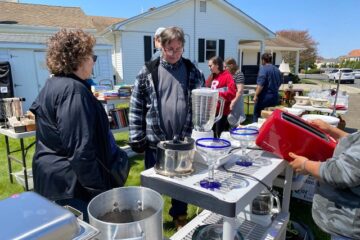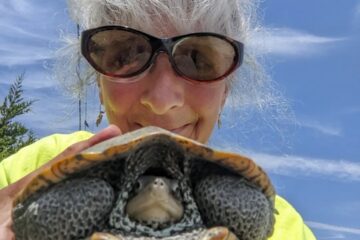By NANETTE LoBIONDO GALLOWAY
LONGPORT – Any avid gardener knows that the most challenging part of gardening is finding the right plant for the right place. It’s mostly trial and error, and constant change. This week, Downbeach gardeners learned how to plant the right plant that won’t be breakfast, lunch and dinner for their voracious wild rabbits.
At a seminar held Tuesday, July 27 at Longport Borough Hall, resident and Sustainable Longport Chairman Tom Subranni, who has more than 40 years of experience gardening in Longport, and landscaper Tony Darpino of Victory Farms, shared their knowledge about the ever-changing list of rabbit-resistant plants.
The Downbeach community has been overrun by rabbits over the last several years, mainly due to the lack of natural predators, but as you travel north toward Ventnor, the rabbit population declines to about 50% in Margate and 25% in Ventnor.
According to the website, peteducate.com, rabbits become sexually mature at four months of age, have a one-month gestation period and does (females) have two uteruses and can be pregnant after giving birth to a litter. They become pregnant every time they mate, and can have up to 13 litters a year and 1-14 babies per litter.
“The population here is so large mainly because you are dealing with very young rabbits who don’t know yet what they shouldn’t eat,” he said. “So they try foods older rabbits won’t eat.”
In winter, when there are no annuals, and perennials die back, the rabbits will eat practically anything, including grass, evergreens and even the bark of a tree.

Longport green team chairman Tom Subranni shows attendees how to make a wire cage to protect their plants, while landscaper Tony Darpino looks on.
“In early spring, the only tender food is new growth on evergreens and they will eat that as high up as they can reach,” Darpino said.
Regardless of the tastiness and tenderness of newly planted garden plants, in the spring the rabbits will eat the entire plant, so Subranni and Darpino recommend planting larger pots. Also, certain popular plant nurseries cultivate their plants to grow bigger and flower longer, which reduces their natural defenses from being eaten by rabbits.
Subranni said plants have natural defense mechanisms that have been developed over millions of years to ward off herbivores, including chemical toxins, mechanical mechanisms such as thorns, hairy or wooly textures, and bitter taste or strong aromatics that ward off predators.
Although rabbits may avoid certain plants one year, they may find them tasty the following year.
“Even if a rabbit eats your plant, it won’t kill the plant. They are just pruning it and sometimes it will grow back,” Subranni said, pointing to a hibiscus plant that was eaten, but recovered after he moved it to higher ground.
A lot of gardening involves experimentation, especially when planting something that is not native, but beautiful enough to bring home from the garden center. If a gardener is unsure if the rabbits will eat a plant, they should plant several and protect one with poultry wire to “test the waters,” Subranni recommended.
“If the rabbits don’t eat the unprotected one, then you have discovered a rabbit-resistant plant,” he said.
He provided the dozen or so attendees with a list of what he deemed “rabbit-resistant” plants after many years of experimentation, which, if used, will still provide a beautiful landscape for resort homes.
He said rabbits will not eat portulaca, which produces drought resistant multi-colored flowers, purple Russian sage and salvia, geraniums, gardenias, lavender, ground cover sedums, and vinca, which comes in many colors. Some rabbit-resistant landscape plants include certain lime variety hydrangeas and barberry, which has double the natural defenses – sharp thorns and berberine toxin. Edibles that are rabbit resistant include basil, chamomile, and nightshade plants, such as tomatoes and eggplant.
Although they avoided talking about how to control the infestation of rabbits, they recommended control be part of a community-based effort that should be undertaken by the municipality with input from the NJ Department of Environmental Protection.
“Leaving out rat poison is not the way to control the population,” Darpino said. “Re-homing them off the island to a forest area where there are natural predators is a possibility,” but then spring comes and the rabbits do what rabbits do…breed like rabbits.
Subranni said local gardeners just have to deal with the problem and try to outsmart the rabbits with their plantings.
“Our Longport rabbits are very refined,” he said. “Just whatever you do, don’t call them bunnies, or you will get letters from little children asking you to save the bunnies.”
Handout: rabbit-resistant-plants
Copyright Mediawize, LLC 2021



